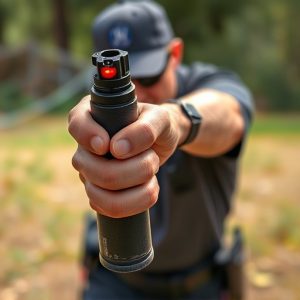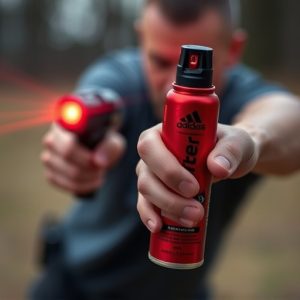Bear Spray vs Personal Pepper Spray: Protecting Yourself Effektively
Capsaicin-based sprays offer powerful protection against threats, with bear spray designed for large…….
Capsaicin-based sprays offer powerful protection against threats, with bear spray designed for large animals like bears at a distance and personal pepper spray tailored to incapacitate human assailants up close. When choosing between them, consider your specific environment: bear spray for outdoor activities in bear country, personal pepper spray for urban self-defense or close-quarters threats. Each option provides unique advantages based on intended use and target.
“In a world where personal safety is paramount, understanding the right defense tools is crucial. This article explores an innovative solution: capsaicin-based personal protection devices. We delve into the science behind capsaicin as the active ingredient and its distinct advantages over traditional bear spray.
Comparing Bear Spray vs. Personal Pepper Spray reveals key differences in application, range, and impact. We guide you through the process of choosing the ideal self-defense tool, ensuring you’re prepared for any situation.”
- Understanding Capsaicin: The Active Ingredient
- Bear Spray vs Personal Pepper Spray: Key Differences
- How These Devices Work and Their Effectiveness
- Choosing the Right Self-Defense Tool for Your Needs
Understanding Capsaicin: The Active Ingredient
Capsaicin, the active ingredient in our personal protection device, is a powerful compound found in chili peppers. Often referred to as the ‘heat’ in spices, capsaicin has been used for centuries not only for flavor but also for its medicinal properties. When incorporated into personal defense products, such as pepper spray, it offers an effective non-lethal option for self-protection against aggressive or dangerous individuals.
Unlike bear spray, which is designed to deter larger animals, personal pepper spray targets the human sensor system, specifically the eyes and respiratory tract. Capsaicin irritates these areas, causing temporary disorientation, coughing, and tears, giving the user precious time to escape from potentially harmful situations. This makes capsaicin-based products a smart choice for individuals seeking personal protection in crowded urban environments or while hiking and camping.
Bear Spray vs Personal Pepper Spray: Key Differences
When it comes to personal protection, both bear spray and personal pepper spray offer effective deterrents against potential threats. However, they serve very different purposes and have distinct characteristics that set them apart. The key difference lies in their target and level of impact. Bear spray is designed specifically for use against larger animals like bears, as its wide range and high concentration of capsaicin can create a safe distance between the user and the attacker. It’s ideal for outdoor enthusiasts hiking or camping in bear country.
In contrast, personal pepper spray is tailored for self-defense scenarios involving humans. This type of spray delivers a targeted blast of capsaicin directly into the eyes and respiratory system of an assailant, temporarily incapacitating them. Its shorter range and higher concentration make it more suitable for close-quarters defense against smaller threats. For individuals living in urban areas or those involved in security professions, personal pepper spray is often the preferred choice due to its effectiveness against potential human aggressors.
How These Devices Work and Their Effectiveness
Capsaicin-based personal protection devices, often in the form of pepper spray or bear spray, work by exploiting a natural chemical compound found in chili peppers. When activated, these devices release a fine mist containing capsaicin, which irritates the eyes, nose, and throat, causing the target to become disoriented and temporarily incapacitated. Unlike traditional pepper spray designed for close-range self-defense, bear spray is formulated to create a larger vapor cloud, making it effective at keeping bears at bay from a safer distance.
While both bear spray and personal pepper spray are potent deterrents, their effectiveness varies based on the specific use case. Pepper spray is highly effective against humans and can provide crucial seconds for escape or help in disarming an assailant. On the other hand, bear spray excels in repelling larger animals like bears, providing a safe margin of safety when hiking or camping in bear-inhabited areas. The choice between them depends on the primary threat one is facing—close-quarters aggression or wildlife encounters.
Choosing the Right Self-Defense Tool for Your Needs
When considering self-defense options, individuals often grapple with the choice between bear spray and personal pepper spray. Each has unique advantages tailored to specific scenarios. Bear spray, for instance, is designed to deter larger animals like bears, using a powerful stream of capsaicin to create a barrier and cause temporary blindness and pain. Its long range and ability to protect against multiple threats make it ideal for outdoor enthusiasts and those in bear-infested areas.
On the other hand, personal pepper spray directly targets human assailants. It’s highly effective at close range, causing immediate disorientation, pain, and temporarily blinding the attacker. This makes it a popular choice for self-defense in urban settings where encounters with hostile individuals are more likely. The direct impact and swift action of pepper spray make it a reliable tool for personal protection in diverse environments.
In choosing between bear spray and personal pepper spray, understanding their distinct properties is key. Both offer valuable self-defense options, but they cater to different scenarios. Bear spray provides a wider range and is ideal for outdoor encounters with bears or other large animals. Personal pepper spray, on the other hand, focuses on close-quarters defense against smaller threats. When selecting your self-defense tool, consider your environment, potential targets, and comfort level with each device. Ultimately, both bear spray and personal pepper spray can serve as effective deterrents when used appropriately, ensuring your safety in various situations.


